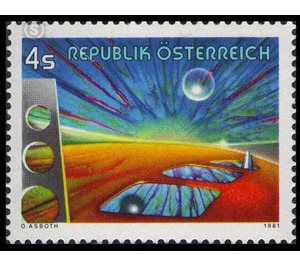Modern Art - Austria / II. Republic of Austria 1981 - 4 Shilling
Theme: Art & Culture
| Country | Austria / II. Republic of Austria |
| Issue Date | 1981 |
| Face Value | 4.00 |
| Color | multi-colored blue |
| Printing Type | offset |
| Stamp Type | Commemorative |
| Item Type | Stamp |
| Chronological Issue Number | 1030 |
| Chronological Chapter | OOS-OE2 |
| SID | 578379 |
| In 58 Wishlists | |
"Between the times" Oscar Asboth calls the work, which can be seen as a motif of this special postage stamp. He expresses a message that accompanies his entire artistic work, as it were his leitmotif: "To put the technology of our time in the timeless space that technology helped us discover". For Asboth's artistic view of things, one has coined an expression to which he confesses himself, metaphysical realism. Asboth's attempt to present technology and the cosmos in new relations is not based on coincidences. Already in his parents' house prevailed the technology. His father went down in history as one of the most important Hungarian inventors. The life of the son, trained in his father's shipyard at a young age as a designer, seemed clearly outlined. But the young Oscar Asboth moved to the Budapest Typographic Research Institute and later to the Art Academy. In 1956 he left the Hungarian homeland and emigrated to Austria.


